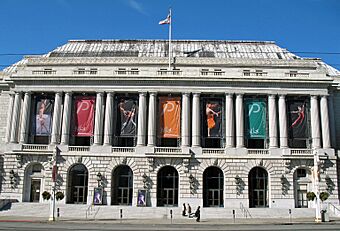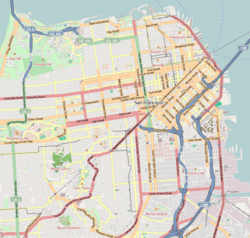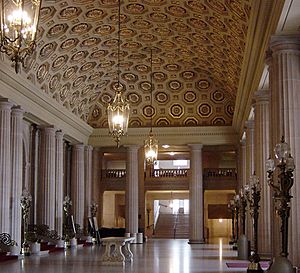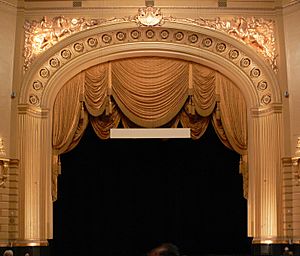War Memorial Opera House facts for kids
 |
|
| Address | 301 Van Ness Avenue San Francisco, California United States |
|---|---|
| Coordinates | 37°46′43″N 122°25′15″W / 37.7786°N 122.4208°W |
| Public transit | |
| Owner | San Francisco War Memorial and Performing Arts Center |
| Type | Opera house |
| Capacity | 3,146 seated 200 standing |
| Construction | |
| Opened | 1932 |
| Rebuilt | 1993 |
| Architect | Arthur Brown Jr., G. Albert Lansburgh |
| Tenants | |
| San Francisco Opera, San Francisco Ballet | |
The War Memorial Opera House is a famous building in San Francisco, California, United States. It is a special place where people go to watch amazing opera and ballet shows. You can find it on Van Ness Avenue, right across from the San Francisco City Hall.
This beautiful building is part of the San Francisco War Memorial and Performing Arts Center. It has been the main home for the San Francisco Opera ever since it first opened its doors in 1932. The Opera House is also very important in history. It was the place where the San Francisco Conference happened in April 1945. This was the very first big meeting of the newly formed United Nations.
Contents
What the Opera House Looks Like
Building this special opera house cost $4 million back in 1927. It was the very first opera house in the United States owned by a city! The main architects who designed the building were Arthur Brown Jr. and G. Albert Lansburgh. Arthur Brown Jr. also designed the San Francisco City Hall nearby. G. Albert Lansburgh was a famous theater designer who worked on other well-known places like San Francisco's Orpheum and the Shrine Auditorium in Los Angeles.
The Opera House was finished in 1932. Its design uses a classic Roman style called the Doric order. This style looks strong and simple, which was perfect for a building meant to honor those who served in World War I. You can see tall, paired columns and large arched windows. The bottom part of the building has a rough, stone-like look, which was inspired by a famous building in Paris called the Louvre Colonnade.
Inside, the Opera House has a grand entrance hall. The ceiling in this hall is shaped like a half-circle and has many carved-out squares, which is called a coffered ceiling. There are also staircases at each end of the hall that lead to overlooks.
The main theater area is very impressive. A huge chandelier made of aluminum and glass hangs from a blue ceiling. The arch around the stage, called the proscenium arch, is decorated with shiny gold sculptures. The theater has seats for 3,146 people, and there's also standing room for 200 more behind the main seating areas.
A Look at Its History
The War Memorial Opera House officially opened on October 15, 1932. The very first performance was an opera called Tosca by Giacomo Puccini. Famous singers like Claudia Muzio and Dino Borgioli performed that night.
For many years, from 1932 to 1980, the San Francisco Symphony also held most of its concerts in this building.
Important Meetings and Events
In the spring of 1945, a very important event happened here. The United Nations held its first big organizing meeting, called the San Francisco Conference, at the Opera House. The official document that created the UN, known as the UN Charter, was later written and signed next door in the Herbst Theatre.
Six years later, in 1951, another historic event took place. The Treaty of San Francisco, which officially ended the war with Japan, was written and signed here and in the Herbst Theatre.
Changes and Upgrades
Over the years, as the San Francisco Opera grew, the building needed more space. In 1974, The Pointer Sisters became the first pop music group to perform at the Opera House, showing its versatility. In 1979, the backstage area was made larger. Then, in 1981, a new section was added to the building. This new part provided more room for sets, coaches, and dancers, as well as more office space. Around the same time, the Zellerbach Rehearsal Hall opened nearby. It has a stage the same size as the Opera House, which is great for practicing.
In 1989, a big earthquake called the Loma Prieta earthquake caused a lot of damage to the Opera House. Because of this, the building needed major repairs and upgrades to make it safer from future earthquakes. This process is called a seismic retrofit.
The renovation work started in 1992. During this time, many improvements were made:
- A brand-new, very advanced lighting system was installed. At the time, it was one of the most modern lighting systems in the world.
- New restrooms were added in areas that were originally meant for an organ that was never installed. This was a much-needed improvement!
- An underground area was built beneath the nearby plaza. This created even more dressing rooms and backstage facilities for performers and crew.
See also
 In Spanish: War Memorial Opera House para niños
In Spanish: War Memorial Opera House para niños




